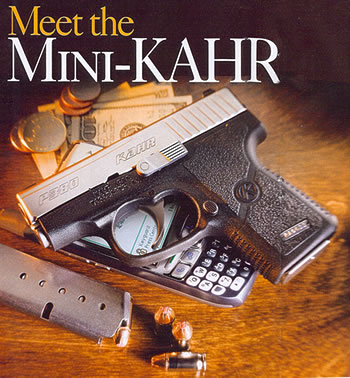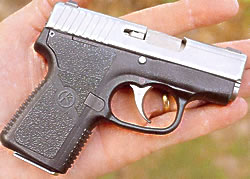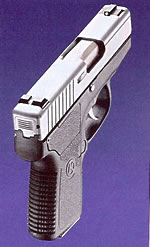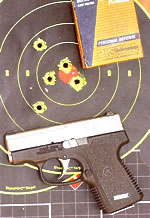- Telephone: 508-795-3919
- Contact Us
- My Account • Dealer Log In
- Technical Support • Service Shipping

Meet the Mini-KAHR
9mm Kurz, 9mm Corto? ln any language, little guns are big all over, and the new P380 appears to be an instant CCW contender.
Guns & Ammo, January 2009, p. 36 - 39
By Patrick Sweeney, Photos; Mustafa Bilal

There was a time, not too long ago, when all anyone wanted were hi-cap pistols. Big guns with lotsa bullets. Of course, we had a moronic legal situation where new magazines of such type were prohibited, which tends to make people want them more.
Since the height of the hi-cap frenzy we've had even more states change their concealed curry laws to “shall issue” from their previous condescending “We'll decide if you need a gun” laws.
But as soon as a lot of people start carrying guns all day, they quickly discover that packing big heat can be a real hassle. Suddenly, you have to be a lot more clothes-conscious. You have to have a sturdier belt than fashion might dictate. And a lot of chairs that had been comfortable are comfy no longer.
The advantages of a small gun are real and can't be jeered away by making snide comments about little calibers. A lot of us are proud to be carrying “mouseguns,” because even a mousegun is better than depending solely on harsh words.
Kahr has been making ever more compact 9mm, .40 and .45 pistols for a number of years now. It has a solid reputation in the gun-toting circles I frequent, which includes non-swom and LEO groups in some of the cities with the highest shooting statistics in the nation. The Kahr users I know all went to the brand for some simple reasons: compactness, ease of use and durability. When it comes t a compact 9mm, .40 or .45, it's hard to beat a Kahr. The ease-of use issue is simple: They are all DAO pistols. And all the Kahrs I've ever seen have worked flawlessly, for me and other owners.


Small guns, big hands, and sometimes things get interesting, but the Kahr P380 never bit the hand that fed it.
Photos: Patrick Sweeney

The P380 is easy to disassemble and thus easy to maintain and keep clean.
Photo: Patrick Sweeney
Which is why a Kahr in .380 is exciting. After all, who doesn't want a durable, stainless, compact .380 that can literally slide into a pocket? Kahr sent me a pair of the new model (SN 9 and SN 22) off the line to handle and test. Before I had time to do more than open the boxes and fondle the pistols I had phone calls and emails telling me to forward No. 9 to our stellar photographer for his love-shot work. However, No. 22 was intended to be shot as much as I could.
What we're looking at here is a pistol that—empty—tips the scales at a smidge under 10 ounces. Less than five inches long, less than four inches tall and three-quarters of an inch wide, the Kahr .380 is significantly smaller than my first cell phone. The grip is short, which means it is easy to conceal, but in my hands my pinkie finger has no place to rest. It's a small price to pay for concealment, and I wonder how long before we see longer mags or magazine extensions that add a round as well as a place for my pinkie. The Kahr 380 is so small that simply getting my mitts to anchor in place took a bit of getting used to. In that regard it doesn't differ from other compact pistols, but you do need to be aware of this when you start practicing. Despite the compact size of the Kahr 380 and the size of my mitts, I never had the problem of the slide rails cutting tracks in my hand.
The lockwork is simple in use: It is a DAO without an external safety but with an internal passive firing-pin safety. So while the trigger may seem a bit longer in stroke than other striker-fired designs, the length of the trigger stroke greatly reduces any chance of inadvertent discharge. While the Kahr 380 is a DAO, it does not have a restrike capacity. So, if you happen to encounter that one-in-10-million dud round, you'll have to rack the slide to both jettison the recalcitrant cartridge and recock the action.
The Kahr 380 is a locked-breech design, explaining a lot of the softer felt recoil than you'd expect in a sub-10-ounce pistol. While nothing that small in .380 Auto is ever going to be soft to shoot (not like a .22LR, for example), it is softer to shoot than my Colt Model M, the pocket pistol Colt stopped making at the end of WWII. Despite its all-steel construction and 24-ounce weight, the Colt does not have less felt recoil than the Kahr.
The Kahr's slide is matte-finished stainless steel, while the frame is polymer for ease of construction, durability and to shrug off perspiration. Really ultra-compact pistols are, for many, a warm-weather choice, and often in the winter we move to bigger guns. So in the summer you're going to sweat on it. But unless your perspiration is more corrosive than New Jersey tap water, you won't find sweating on your Kahr to be a problem.
Disassembly is a snap. Once it's unloaded, line up the witness marks in the slide and frame (or simply eyeball the alignment of the slide-stop and the oval notch in the slide) and press out the slide stop from the left. Then you have the only tricky part in disassembly: As you pull off the slide, you have to dry-fire the frame to release the cocking cam from the striker. When you do this you'll notice that the Kahr .380 does not have a magazine safety. Considering the compact size of the Kahr, and the demonstrated distaste many have for such devices, I'm not surprised Kahr left it off. Just be aware that if you live in a jurisdiction that requires such things, you won't be able to shop for a Kahr. The recoil spring is a dual-coil design, with the inner spring given a left-hand spiral so it can't bind against the outside spring. The standard spring reassembly applies: The closed end goes on the guide rod, against the flange. Doing it the other way may not make a difference, but I've had some manufacturers tell me it greatly shortens spring life.
From there, disassembly is standard: spring out; barrel down and back out; you're done. You need not do any other disassembly, and everything you see can be cleaned with aerosol clears and relubed before reassembly. If you do use the P380 as your daily carry piece, I suggest doing the takedown and check once a week and going light on the lube. You want to strip and clean to get out the dust bunnies and lint and go easy on the lube.
The magazines themselves are singlestack, sturdily made and have steel baseplates. No need to worry about losing ammo from a shattered baseplate. As it's a compact carry gun, you aren't going to have a lot of capacity. However, the Kahr holds the compact .380 standard: six rounds, and you get a spare magazine with your pistol. So, when you buy your holster for your Kahr, invest in a spare magazine carrier. Nestle it behind your cell phone or PDA pouch, and no one will ever notice it. You, however, will have it if you need it.

Despite its diminuitive dimensions, the Kahr .380 features a broad sighting plane.

High-speed hollowpoints and a group just over three inches at 25 yards? Not bad for an ultra-compact .380.
Photo: Patrick Sweeney
The slide strips round out of the magazine right into and up a feed ramp that is integral with the barrel. No frame-to-barrel gap for the rounds to jump across, and the integral ramp design allows the Kahr engineers to use that space for the locking cam, which is kidney-shaped and tracks on the slide stop shaft, as all Browning-derived designs do. The P380 barrel is a grand total of 2 inches long, plenty long enough to generate .380 velocity and deliver accuracy if you're up to it. The bore has polygonal rifling, which bodes well both for accuracy and longevity. As a bonus, the Kahr P380 has an auto slide hold-open. That's right, an ultra-compact .380 that locks open when it is done. What's not to love?
Shooting the Kahr required that I get back in touch with my snubbie side. The relatively long (but not very heavy) DA trigger pull, combined with the short barrel and sight radius, required that I exercise proper follow-through. Given the small size of the pistol relative to my hands, if I did not pay attention (as we all should on all firearms) to the follow-through, I'd throw shots left. It only took a couple of “Darn, left again” shots to remind me that it was just like shooting a two-inch revolver and then mentally shift to the proper trigger press. Once I did that, it was simple to shoot the Kahr well. As you'd expect, it shot the JHPs I had along to a greater level of accuracy than the hardball. Such is the nature of ammo. Jacketed HPs tend to be more accurate, and many view hardball as “vanilla-plain blasting ammo” and thus they are not at all disappointed with a bit less accuracy.
The sights are definitely low-profile, with the rear sight having a rectangular white spot below the notch. The front has a white dot inside a milled or drilled recess. The sights are steel, so you have less worry of damage in daily handling. In use, you would simply put one dot over the other, with both dots on the miscreants sternum, and have at it. Shooting groups, I almost went back to the truck and broke out the black spray paint. While fast, a dual dot system like this is hard on the caffeine-ravaged trigger finger and eyesight of your loyal scribe. But, by use of a bit of shade and a solid bench I was able to shoot up to the potential of the Kahr. Which is pretty darned good, when you consider I'm aiming across a sight radius of only 3-1/4 inches and using a barrel with 1-1/2 inches of rifling to steer my shots.
The Winchester 95-grain FMJs produced groups that were four inches or so in diameter. The hi-tech JHPs did better, and I didn't have any failures while testing for velocity, accuracy or plinking. Using a compact .380 with small sights is not likely to boost one's ego while plinking at 100 yards. However, encouraged by the bench groups at 25 yards, I decided to entertain myself on the club's gong. I'm glad I did, as the Kahr P380 proved to be both an enjoyable plinker and a very useful shooting coach. If I did everything right I could hit the gong about half the time, standing. (Think about that: a scaled-down USPSA silhouette, at 100 yards.) If I didn't, I could see in follow-through that the bullet strike was almost always off to the left. Spend an afternoon paying attention to the basics while plinking with this little pistol and you will be a much better shot.
Knowing the Kahr's attention to detail and rugged design, I'm sure if anyone gets around to loading some .380+P ammo the P380 will be able to handle it. It will probably do a much better job of it than you would. If you do try it, you'll want to contact Kahr and get an extra recoil spring. Small pistols and hot loads greatly shorten the life of a recoil spring, and I'd hate for you to have a problem because you overlooked that detail.
Just when you thought life was simple, that picking an ultra-compact .380 was an easy decision, Kahr had to go and make things complicated again. Sometimes, complicated is good.
| ACCURACY RESULTS | |||
|---|---|---|---|
| Load | Bullet Weight (gr.) | Avg.Velocity (fps) | Average Group (in.) |
| Winchester FMJ | 95 | 800 | 4.0 |
| Federal Hydra-Shok | 90 | 857 | 3.0 |
| Winchester SXT/JHP | 95 | 777 | 3.0 |
| Hornady XTP/JHP | 90 | 859 | 3.0 |
| Hornady Critical Det. | 90 | 847 | 3.0 |
| Velocity recorded 10 feet from the muzzle using a 10-shot average. Groups are the average of three five-shot groups from a sandbag rest at 25 yards. | |||
<< Go back to Previous Page
